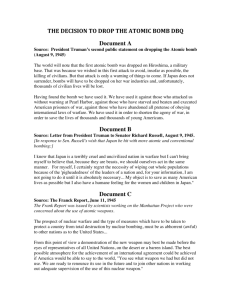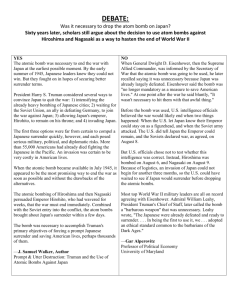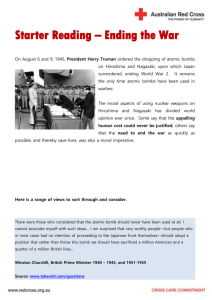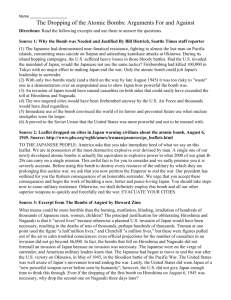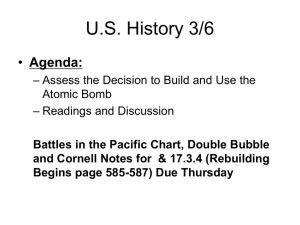WWII - Pacific - pams
advertisement
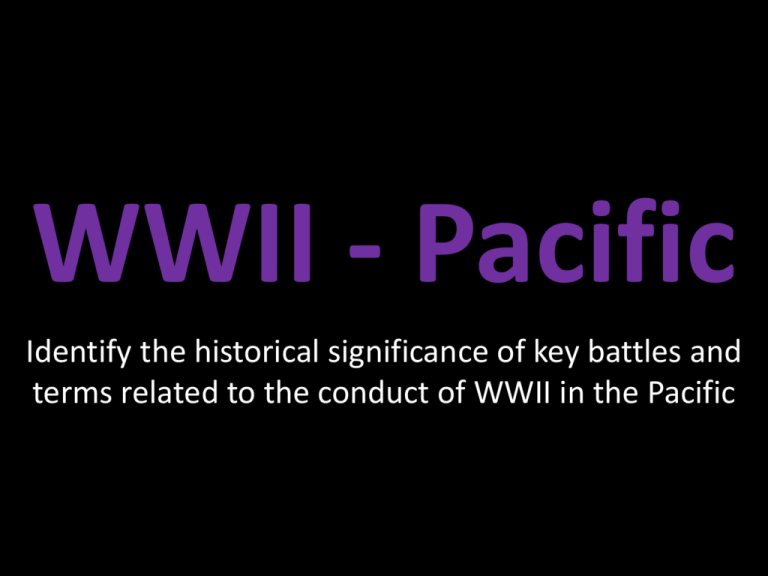
WWII - Pacific Identify the historical significance of key battles and terms related to the conduct of WWII in the Pacific Meanwhile in Japan . . . Japan’s Need for Resources – April 1942 • Japan invades the Philippines – Bataan Death March Douglas MacArthur • Commander of the US forces in the Pacific • His most famous statements: “I Shall Return” – upon leaving the Philippine Islands when the Japanese occupied them, and “I Have Returned!” when the United States reclaimed the Philippine Islands. Island Hopping US strategy to defeat Japan 1. Start with a small defenseless island 2. Take over – establish ports and airstrips 3. Be one “step” (island) closer to Japanese mainland 4. WIN! Iwo Jima – February 1945 • Battle where the US took the Japanese island of Iwo Jima as part of it’s island hopping strategy Kamikaze • Term for Japanese pilots • Translates to: “divine wind” • During the end of WWII, desperate Japanese leaders recruited men to serve as suicide pilots – promising them eternal life in heaven in exchange for their lives. The men target ships with their heavily armed airplanes, then crashed into the ship. Battle of Midway – June 1942 • Turning point of the war in the Pacific • Resulted in the losses of four Japanese aircraft carriers (out of six in the entire Japanese Imperial Navy.) The American ship Yorktown, which was heavily damaged at Coral Sea, was ultimately downed during the battle as well. The Atomic Bomb Debating the use of the atomic bomb over Japanese cities - WWII Manhattan Project – 1942-1946 • A top-secret program set up by the US government to develop and test an atomic bomb • Led by scientist J. Robert Oppenheimer – “the father of the atomic bomb” • Suggested by none other than Albert Einstein, who feared that the Germans would create the weapon first, the program was completed at Oak Ridge, TN and Los Alamos, NM. Leading to Deployment • U.S. military suggested showing Japanese footage of possible destruction – declined by high ranking officials • Great Britain was made aware of U.S. atomic plans and agreed to having presence if the bombs were dropped • Months earlier, 63 million leaflets dropped warning civilians of air raids – 12 cities were listed - Hiroshima was NOT one of them • July 26, ultimatum given: – "the inevitable and complete destruction of the Japanese armed forces and just as inevitably the utter devastation of the Japanese homeland". – No mention of atomic weaponry Hiroshima – August 6, 1945 • First atomic bomb used in war • Significant military supply and industrial city • The bombing of Hiroshima, Japan was the dawn of the atomic age. The city of approximately 120,000 people was reduced to rubble instantaneously. The plane Enola Gay dropped the bomb on Hiroshima, after having taken off from Okinawa, Japan. Leading to Deployment . . . again • August 7-9: – Truman warns of a second and more powerful bomb • August 9 – Soviets declare war on Japan • August 9, 1945 President Truman, – “I realize the tragic significance of the atomic bomb ... It is an awful responsibility which has come to us ... We thank God that it has come to us, instead of to our enemies; and we pray that He may guide us to use it in His ways and for His purposes.” Nagasaki – August 9, 1945 • Second site of the atomic bomb over Japan • Military vessel industrial zone • The decision to use a nuclear weapon against civilian populations in Hiroshima and Nagasaki is still a controversial one – some maintain that it was simply murder. Harry Truman, however, explained that an invasion of Japan’s main islands would easily have cost one million American lives and perhaps even more Japanese lives – military and civilian. Aftermath • More bombs were ready: – August 19 – Three more in September – Three more in October • Soviet Union invades Manchuria • August 14 – Emperor Hirohito: – “Moreover, the enemy now possesses a new and terrible weapon with the power to destroy many innocent lives and do incalculable damage. Should we continue to fight, not only would it result in an ultimate collapse and obliteration of the Japanese nation, but also it would lead to the total extinction of human civilization.” VIDEOS • Show – Hiroshima Atomic Bomb (1945) – Hiroshima Nuclear (Atomic) Bomb – USA attack – Atomic Bombing of Nagasaki - BBC V-J Day – August 14, 1945 • Unofficial surrender of the Japanese to the US Unconditional Surrender – September 2, 1945 • The Japanese officially surrendered to the US on board the USS Missouri, on September 2, 1945. • General MacArthur accepted the surrender • He served as governor of the islands during its Reconstruction after WWII, planting the seeds of democracy and individual rights in Japan
